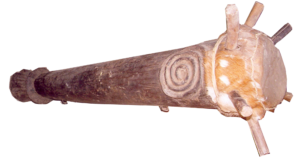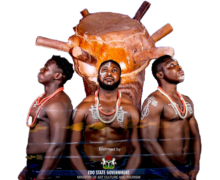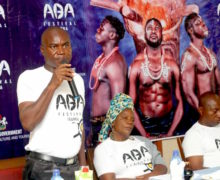
History of Aba Cultural Festival
The origin of the Aba Cultural Festival is almost lost to memory due to lack of historical records. It is originally a celebration of victory by the hunters over the initial settlers of the land now known and described as Igarra-Etuno. That is why most of the songs are the original hunters’ songs of victory.
Eziakuta Family hunting expedition made them fearless, brave and bold. No wonder therefore that their role in the migration of ANETUNOS from Kwararafa (Junkun Kingdom) in Wukari, through Idah and other places to Ebira land and finally to Akoko-Edo is most undoubted. Apart from being reliable, even when fighting against the European colonial masters, they are owners and custodians of most Igarra rich cultures, among which is the famous Aba Festival.

The historic Aba festival drum.
The Aba Festival is the most spectacular/singular event in the celebration of Irepa Festival. It is the highest crowd-pulling of all the Irepa Festival events. Available records show that the event was first celebrated in 1789, even though we have a trace of it to 1678, long before the arrival of the Europeans and the creation of modern day Nigeria. It is an age-long and internationally acclaimed festival adjudged as the sixth most indigenous festival in the whole of West Africa by Total E&P in their 2006 yearly publications.
The celebration of Aba festival in Igarra marks the commencement of Irepa/Azebani title ceremony. And it takes place every seven lunar or six global calendar years and usually on the third day after the ENU – the New Yam Festival of the same Irepa year, and which is usually in the month of August. The New Yam Festival is an annual event. The main event of the 2017 IREPA Festival is on the 25th day of August, 2017 – which marks the graduation of the town’s (Legislative and law enforcement) Age Group, called OPOZE (Opa Avineve Age Group) to the highly revered Council of Elders called the AZEBANI.
The Opoze Age Group is unique in the sense that it is always the center of attraction during the festival because having been at the helms of affairs of the town (making laws and enforcing same) for six years, its members are the Chief Celebrants of the occasion.
On the day of the event, no other person is allowed to wear any white attire except the celebrants (the graduating Opoze) who would all climb a sacred Opoporiku Hills, the community’s Cultural Headquarters. This special day is preceded in the evening of the previous day by the shooting of ceremonial dance guns and cannons, first in the compound of the ODOVIDI i.e. the leader of the Age Group who must be the oldest celebrant from Eziakuta Opoporiku family by 2pm and followed by all the other celebrants by 4pm.
The morning of the Festival day is usually heralded with tremendous entertainment of food and drinks, usually prepared by the major celebrants, the graduating Opoze Age Group. A major delicacy is the pounded yam, which every celebrant prepares for members of his family and kindred. Assorted drinks and bush meat go with these, not to talk of drinks and this continues until everyone is exhausted. After this, it will be time to ‘let the steam off’ by each family member accompanying his celebrant(s) to ‘Ofumamo’, the cultural headquarters.
By noon movements to and fro the venue is usually regulated by special traffic squad, made up of EYA Traffic Marshalls, who are specially trained by the Federals Road Safety Corps (FRSC) for this purpose. While Ugbogbo celebrants gather at the junction leading to the venue of the celebrations, their colleagues from Utua and Uffa will meet them at the junction, so that together, they process, magnificently to ‘Ofumamo ’the cultural centre. By noon the celebrants clad up in immaculate white Agbada, white shoes and cap to match – assemble at designated places to dance to Ofumamo at Opoporiku along Somorika road, Ugbogbo. Celebrants from Uffa will gather at Uneh, enroute to Ofumamo who are joined by their Utua colleagues and move in the same convoy to Ugbogbo. At Somorika junction (Ugbogbo Central Market) they are joined by the Ugbogbo people then the “Great trek” to Ofumamo begins.
It is pertinent to note that the celebrants usually dress in immaculate white Agbada attire with bells/white horsetail, cap and shoes to match. As a mark of honour to these revered celebrants, no other person, (no matter how highly placed) is allowed to wear anything with a trace of white on that day.
At Ofumamo, in Opoporiku, the (Cultural headquarters) of Igarra the Aba drums which must have been set ready at the Iretuba – a stone at the centre of Ofumamo, by the owners and custodians (EziakutaOpoporiku family), are beaten for the celebrants to dance from where they are specially gathered. They are followed by Opoga the celebrants successors who had specially stayed on the Agidibobo rock. The celebrants dance and descend from where they stand, which symbolizes their relinquishing of their Legislative, other roles, powers and duties to their successors. This confirms the ascension of each of the other age group into the age group system of the community. At this point, the Azebanis (Council of Elders) will send message to the celebrants to pay the Irepa fees, and they will respond by paying the fees. This payment qualifies them (celebrants) to take the Azabani/Irepa titles from their various family heads at a later date. Although the Aba drum and Irapa are always kept in the custody of the oldest man in ‘Abara’ Onubeji House of Eziakuta Opoporiku Family but every ‘Opoporiku’ man has free access and have the right to beat the drum in every Aba Cultural Festival Day.
The forthcoming celebration is the 38th in the history of the peace-loving and highly amiable Igarra community. Igarra people from all walks of life, nooks and crannies of the globe with friends and well-wishers will come home either to witness or take part in it. The festival has witnessed a huge upsurge in the member of tourists attending the festival particularly the last edition; the 37th series witnessed over three hundred and fifty thousand local and international tourists.
The Aba 2017 Cultural event, the fourth since the return to civil rule in Nigeria, promises to be the biggest, largest crowd-pulling and most spectacular festival ever as innovations and other activities have been introduced to the festival since it was first celebrated about three hundred years ago. With the new repackaging of the festival by Etuno Youth Association (EYA) and Edo State Government endorsement as partner in the Aba project, the number of tourists being expected at the 38th series will be well over seven hundred and fifty thousand people, as Opoze Age Group (Opa Avinebe) has over five thousand members as celebrants alone.
Aba Festival is becoming a huge tourist attraction and one can only hope that someday it could become something bigger and even more revered than the Iwude Festival, the Osun Osogbo Festival, the Argungun Fishing Festival, the Ojude Oba Festival with international clout and flavour. Therefore, plans are on by the ETUNO YOUTH ASSOCIATION (EYA) to list the festival on the calendar of World Tourism Organisation (WTO) as well as on the World Heritage Festival of UNESCO.



Connect with us: